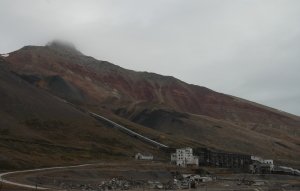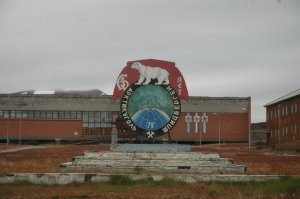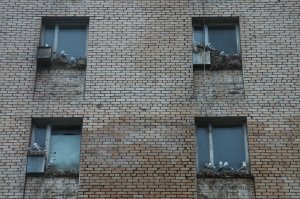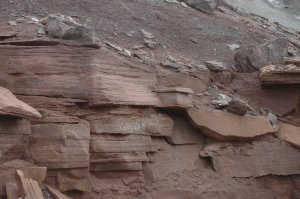Svalbard. What comes to mind? Polar bears that eat kids alive if they don’t carry guns in the settlement. Which they do. At least the parents. Dark as a coal mine half the year, even outside the coal mines. Bright as sun 24/7 the other half because…well, there is sun 24/7. Cheap booze. Cute, cuddly round reindeers. Stupid tourists.
And awesome geology. Norwegians, used to the hard basement and nappe bedrock of the Mainland, get enthralled by the beauty of the sedimentary rocks. Most tourists let it be at that, sediments and coal mines, but Svalbard offers geology all the way from the Precambrian, from tropical coral reefs to the cold glaciers of today.
Join me for a journey through time, to the places I have seen at several visits to the archipelago. We will see rift basins with deserts and salt, like very dry areas of the Gulf or Rift Valley today. Coal from old swamps, coral reefs, fine shale from a deep shelf, where we can follow the advance of a coastline until sea becomes land with dinosaurs. And we will see how a small mountain chain came by, when Svalbard squeezed by Greenland. All beautifully exposed, thanks to almost no vegetation, courtesy of the cold climate.
Let’s start in the Carboniferous. Because that is the oldest on Svalbard I have visited myself. Svalbard was just North of Equator (in the Carboniferous, not when I visted) with a wet and humid climate, lots of swamps, the time when land plants clinched their conquer of land, led to an enormous increase in biomass, and when the biomass – aka trees and plants – died, they got buried and became coal (hint: he name Carboniferous).
At this time, the future Barents sea decided to continue stretching along old weakness zones left behind from the collapse of the Caledonian mountain chain, and the faulting created long, wide valleys lining up north-South, with swamps that later became coal. For many years, Carboniferous coal was mined in the Russian settlement Pyramiden (the Pyramid, after the characteristic shape of the mountain the mine ate into). Pyramiden lies at the upper flank of such a valley, the Billefjorden trough, and a series of faults have created stairsteps of fault blocks down into the trough – the “graben” in geo-speak. When the coal in the Pyramiden mountain itself was empty, the Russian miners had to dig progressively deeper into the coal layers in those stairsteps, until the remaining coal became too deep and expensive to mine. Pyramiden closed in 1998.

Pyramiden – the mountain and the mine works. The long tube up from the buildings protected the lift for mine workers to the mine entrance higher in the mountainside. A necessity in the dark Svalbard winter! The dark coal dumps mark the location of the coal seam itself, and above them are the interchanging white anhydrite and red sandstones of the Billefjorden group. Note how the sand wedges out to the right, and thickens to the left, towards the main graben border fault, just outside the image. The nearly ever-present cloud on the top hides the “hat” of hard limestone.
Wait – Russians? Isn’t Svalbard Norwegian? Yes, but if Svalbard had a Facebook relationship status it would be “It’s complicated”.
Svalbard actually means “cold egde” or “cold coast” in old Norwegian, and was probably sporadically known to the Vikings. Dutchman Willem Barentsz (re?-)discovered it in 1596, giving it the more internationally known name of Spitsbergen (“sharp peaks” in Dutch), but which actually is the name of the biggest island of the archipelago. Barentsz got the Barents Sea named after him, followed by a trail of hunters for whale blubber, then fur hunters, fishing and in the 19th century rushes for coal and minerals. Svalbard became a cowboyland, a no-man’s land with cheating, claim jumping and feuds. None of the small scale mining operations became profitable, due to the logistic challenges and climate, until the American industry magnate John Munro Longyear started industrial scale production in what today is Longyearbyen (Longyear city – probably an appropriate name during the dark winter).
The countries with interests around the arctic realised it was time to end the chaos on Svalbard, and negotiated the Svalbard Treaty in 1920. The agreement gave Norway ownership of the islands, but also gave all countries that signed the treaty rights to live and do economic activity there. (It also prohibited import restrictions and that Norway could collect taxes on Svalbard that are not spent there, which today means that alcohol and imported meat is cheap, while vegetables and milk are expensive due to transport costs). In practice, Svalbard was as cold and remote as before, and mining was only occasionally profitable, but something else ensured that both Norway and Russia continued their presence: The Cold War.

If an artist had made this image, it would probably be entitled “Without Title”, and a long explanation of how it captures the melancholia of glory days long gone.
Norway subsidised coal mining in Longyerabyen, Svea (taken over from a Swedish company in 1934) and Ny-Ålesund (closed after a serious accident in 1962). Russia commenced mining in Pyramiden in 1939, in 1932 they took over the Duch settlement Barentsburg and also for a short time in the small settlements of Coles bay and Grumant. Today, Svea is the main focus of Norwegian mining, in Longyearbyen only one mine is in operation, partly to supply the local powerplant. The Russians continue in Barentsburg.
But we digress. All the other coal mines dig in the Cenozoic, so let’s leave them for now (and leave you excitingly waiting for that chapter!), and go back to the Carboniferous and its rifts.
The rifts continued to develop at the same time as the climate became drier, because Svalbard drifted further north, into the dry zone north of Equator. Coal swamps gave way to something like the Persian gulf today: Gravel, sand, salt and limestone following each other, in a poster example of how the combined effects of fault activity and sea level changes control which type of sediments that are deposited. When the faults moved and created a void – the valley – coarse sediments, gravel and conglomerate, flowed down from the fault-defined valley sides and settled at their foot, or followed the steeper rivers – from annual floods – a bit out in the valley. Then, the valley filled up, rivers became a bit gentler, and the sediments became sand. The sand is deep rusty red, showing that it deposited on land.
At this time, in the middle Carboniferous, there was a sea south of Svalbard, known from rocks on Bjørnøya and oil exploration wells. This sea occasionally ate its way up to Svalbad itself. Fault rifts like the Billefjorden trough tend to continue to sag in after the fault movements have ceased – “post-rift subsidence” in geo-speak – and then the valley bottom came below sea level, possibly helped by more regional and global sea level fluctuations. In the dry climate the valleys became isolated arms of the sea, that occasionally dried out, just like part of the Persian gulf and the Big Salt lake today, and laid down salt. Most of the salt is white anhydrite, a calcium sulphate that basically is gypsum without any water. Then, the valley basin sunk in even more, the sea flooded it, and it became less salty. Instead, the seafloor was covered by tiny shells, from zillions of microorganisms that lived in the water, and whose shells then sank to the bottom.

Red Continental sandstone, white evaporite salt, thin dark shale beds, blue-greyish carbonate…the changing environments in the Billfjorden graben created a colorful palette!
Lather, rinse and repeat. The sea level sank, or renewed faulting spit coarse sediments into the valley-sea once more. This cycle of sand, salt and chalk is repeated several times in the Billefjorden trough, and gives the rocks a colourful pattern: red sandstone, white anhydrite, blue-greyish limestone. In fact, a mountain close by Pyramiden is called Trikolorfjellet – the Tricolor Mountain, just like the French flag.

Geologists @ work in the Arctic :): Walking into the valley in Billefjorden, with a glacier in sight. The dark rocks at distance are actually basement rocks in the footwall, behind the
Billefjorden graben.
But nothing in this world lasts eternally, not even chess matches (although they may feel so), or rift episodes. As the Carboniferous came towards an end, rifting ceased, the ocean flooded Svalbard and laid down a thick blanket of limestone – that topped the Pyramiden mountain with a nice grey-white hat.
Limestone has the funny property of often being hard and resistant to mechanic erosion, while at the same time, it is easy to solve chemically. Carbonate minerals, especially calcium carbonate dissolves by the weak acids in rainwater. The most usual acid in rainwater (before man started burning coal) was weak carbon-acid formed by connecting natural CO2 water vapour in the atmosphere, with sulphuric acid from sulphide minerals playing a minor role.
The acid reacts with the carbonate, and forms a calcium salt and carbondioxide, which floats away with the water, leaving holes behind. Small holes, like the ones that makes a nice porous reservoir on the recent Gotha and Alta oil discoveries in the SW Barents sea, or big holes: The largest limestone cave chamber in the world, on Borneo has space for several jumbojets. In geospeak, the process is called karstification, and the result a karst landscape, after a location in Slovenia.
On Svalbard there are no big holes, but many small ones. In Billefjorden, sailing out from Pyramiden, one can see how the limestone is holed out like a cheese by small caves.

Like a medieval castle on top of the hill: A hard limestone cap on top of the sand and salt, with Gothic windows created by karst solution of carbonate.

Game of Thrones? No, just layers of hard limestone o top of the softer clastics, and with windows formed by karst dissolution.
These holes also prove that sometime, after the limestone deposited, the area was above sea level, because karst is caused by rainwater hitting the rock. But that could be anything from some thousands to many millions of years. Leaving the thick late Carbonferous limestones in Billefjorden, we also enter the Permian – and that will be the next blog post.






Pingback: Fjordblock island: The Upper Permian of Svalbard | Karsten Eig·
Pingback: Karsten makes a mistake on karst | Karsten Eig·
Pingback: Politics in stone: Svalbard’s Cenozoic coal | Karsten Eig·
Pingback: Glaciers: The slow sculptors | Karsten Eig·
I cannot easily stop reading your blog!
Being an amateur, I stumbled upon your statement: “… sand is deep rusty red, showing that it deposited on land. ”
Do you happen to have a link or explanation?
https://en.wikipedia.org/wiki/Rust
:)
The point is that iron oxidised on land is typically red Fe3+, but in the sea it is more often green Fe2+.
Thanks!
So the sand gets deposited togeher with the iron and that iron is/gets oxidized ~ during/straight after deposition, at least before further burial? Is there something to say about the iron supplier?
Hi again! The iron is typically part of the minerals in the sand, and then weathers out from the mineral grains, and oxidises :)
It’s clear that you and I are very much alike. We write and only much later realize we dropped a “t” in the or an “ed” now and then. Been pondering getting my PhD in geology for various reasons (mainly to offset the wife’s in linguistics) and it’s blogs like this that encourage me to continue my studies.
Just wanted you to know your blog is awesome and I love the pictures, science and humor.